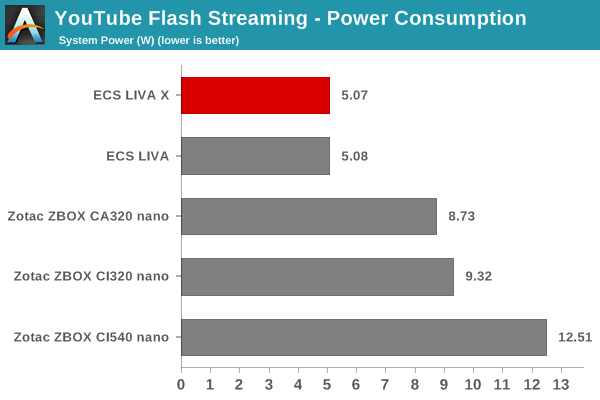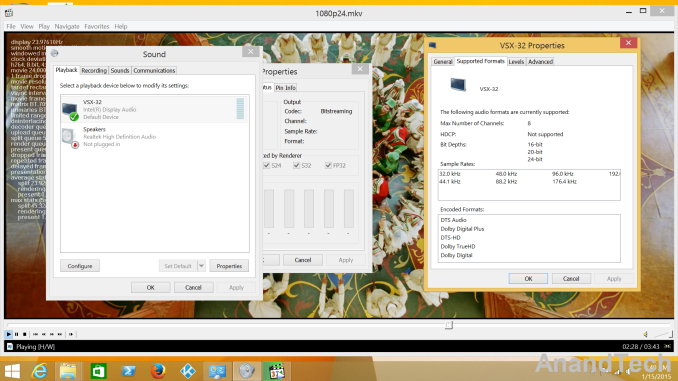ECS LIVA X Review: A Fanless Bay Trail-M mini-PC
by Ganesh T S on January 16, 2015 11:30 AM ESTHTPC Credentials
Given the ECS LIVA X's fanless nature and the presence of Intel HD Graphics, we expect most purchasers to use it as a media playback machine / HTPC. Given the specifications, it is quite clear that we are not looking at a madVR capable machine, but one targeted at the entry-level / average HTPC user or someone looking for a HTPC to put in a second or third room (non-primary HTPC). There are two HTPC aspects that we will explore in this section, one related to network streaming (OTT services), and the other related to local file playback. Prior to that, we have a small sub-section dealing with refresh rate accuracy.
Refresh Rate Accurancy
AMD and NVIDIA have historically been able to provide fine-grained control over display refresh rates. The default rates are also quite accurate. Intel used to have an issue with 23 Hz (23.976 Hz, to be more accurate) support, but that was resolved with the introduction of Bay Trail and Haswell. As expected, the ECS LIVA X has no trouble with refreshing the display appropriately in the 23 Hz setting.
The gallery below presents some of the other refresh rates that we tested out. The first statistic in madVR's OSD indicates the display refresh rate.
Network Streaming Efficiency
Evaluation of OTT playback efficiency was done by playing back our standard YouTube test stream and five minutes from our standard Netflix test title. Using HTML5, the YouTube stream plays back a 720p encoding, while Adobe Flash delivers a 1080p stream. Note that only NVIDIA exposes GPU and VPU loads separately. Both Intel and AMD bundle the decoder load along with the GPU load. The following two graphs show the power consumption at the wall for playback of the HTML5 stream and the Adobe Flash stream in Mozilla Firefox (v 35.0). The Flash plugin version used for benchmarking was 16.0.0.257. GPU load was around 36.04% for the HTML5 stream and 23.34% for the Flash stream.


Netflix streaming evaluation was done using the Windows 8.1 Netflix app. Manual stream selection is available (Ctrl-Alt-Shift-S) and debug information / statistics can also be viewed (Ctrl-Alt-Shift-D). Statistics collected for the YouTube streaming experiment were also collected here. GPU load in the steady state for the Netflix streaming case was 3.82%.

The ECS LIVA X easily manages to be the most power efficient of the passively cooled PCs that we have evaluated so far.
Decoding and Rendering Benchmarks
In order to evaluate local file playback in the ECS LIVA X, we concentrate on EVR-CP and Kodi. We already know that EVR works quite well even with the Intel IGP for our test streams. The decoder used was LAV Filters bundled with MPC-HC v1.7.7 for EVR-CP and hardware accelerated decoding enabled (default configuration) for Kodi 14.0
| ECS LIVA X - Decoding & Rendering Performance | ||||
| Stream | EVR-CP | XBMC | ||
| GPU Load (%) | Power (W) | GPU Load (%) | Power (W) | |
| 480i60 MPEG2 | 52.95 | 5.87 | 30.87 | 5.07 |
| 576i50 H264 | 48.12 | 5.81 | 56.95 | 5.81 |
| 720p60 H264 | 58.44 | 6.57 | 66.45 | 6.31 |
| 1080i60 MPEG2 | 85.72 | 7.96 | 82.44 | 7.21 |
| 1080i60 H264 | 95.96 | 8.62 | 86.87 | 8.09 |
| 1080i60 VC1 | 92.40 | 8.27 | 83.84 | 7.95 |
| 1080p60 H264 | 75.15 | 7.61 | 67.37 | 6.65 |
| 1080p24 H264 | 30.91 | 5.52 | 26.54 | 5.05 |
| 4Kp30 H264 | 81.67 | 7.83 | 45.93 | 6.05 |
The number of streams / decoder - renderer combinataions with issues is lower than what we had with the ECS LIVA - probably due to the slight bump in the clock speeds.
In our Zotac ZBOX CI320 nano review, I had erroneously mentioned that HD audio bitstreaming was not working for Bay Trail-M based systems. This turned out to be a pilot error - HD audio bitstreaming works if the drivers are directly downloaded off Intel's website.
In addition to usage as a HTPC / media playback machine with Windows 8 / 8.1, OpenELEC is also well supported for users who don't want to pay the OS tax. The ECS LIVA X is a nice little media playback machine with decent enough CPU performance for those who don't have too much 60 fps interlaced content.

















35 Comments
View All Comments
zepi - Friday, January 16, 2015 - link
HEVC / H.265 decoding capabilities would also be of interest for all HTPC tests.Otherwise these are solid articles about htpc's.
YoloPascual - Friday, January 16, 2015 - link
Well, this might be the best looking NUC out there.yannigr2 - Friday, January 16, 2015 - link
Could you please try to do a review for this one?http://linuxgizmos.com/tiny-fanless-mini-pc-runs-l...
It looks much more interesting than the LIVA.
kaidenshi - Friday, January 16, 2015 - link
Ooo, the multi-LAN version of that would work great as a custom router/firewall!speculatrix - Wednesday, January 28, 2015 - link
Phoronix.com looked at the fitlettakeshi7 - Friday, January 16, 2015 - link
I think the Zotac PI320 is a much better value. It's $50 cheaper, has 2 more cores and comes with an OS. The only real advantage I see in this is more RAM.Oxford Guy - Monday, January 19, 2015 - link
What does anyone need those extra cores for?eanazag - Friday, January 16, 2015 - link
I'd like to see VGA ports die already, but I understand they may have customers looking for that. I'd rather see the HDMI and a DP port for the video out.kaidenshi - Friday, January 16, 2015 - link
At first I had the same reaction as you, then I remembered that a lot of digital signage (a target market for these devices) still uses VGA. Hell, I still have a 15" VGA only LCD around here somewhere, and I would be able to slap this on the back and make a great "kitchen PC" for when I'm cooking and need to research ingredients or methods.But yes, a DisplayPort or mini DisplayPort connector would make more sense, given how cheap DP to VGA adapters are.
jabber - Saturday, January 17, 2015 - link
I think what you are looking for there is a laptop.